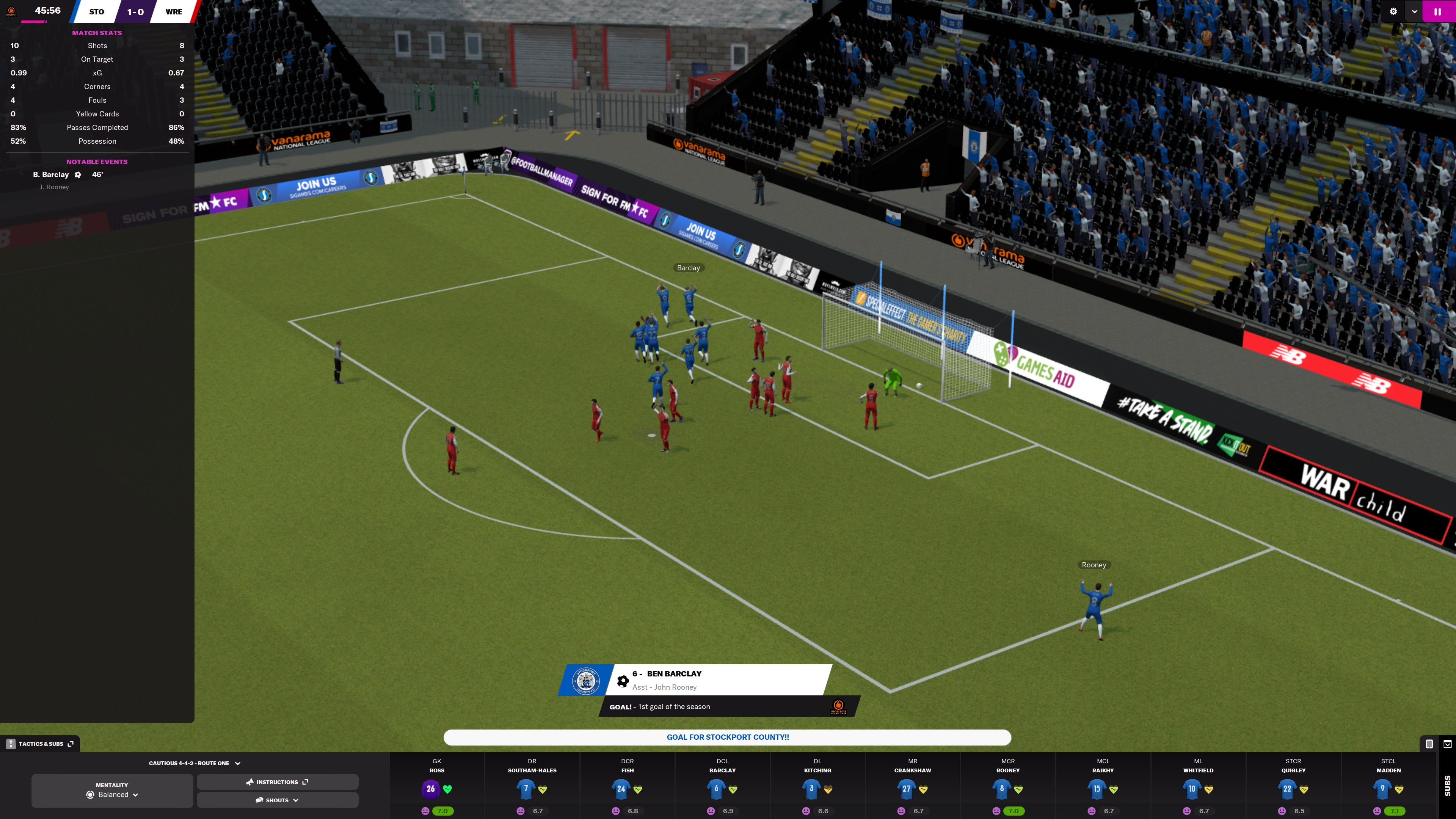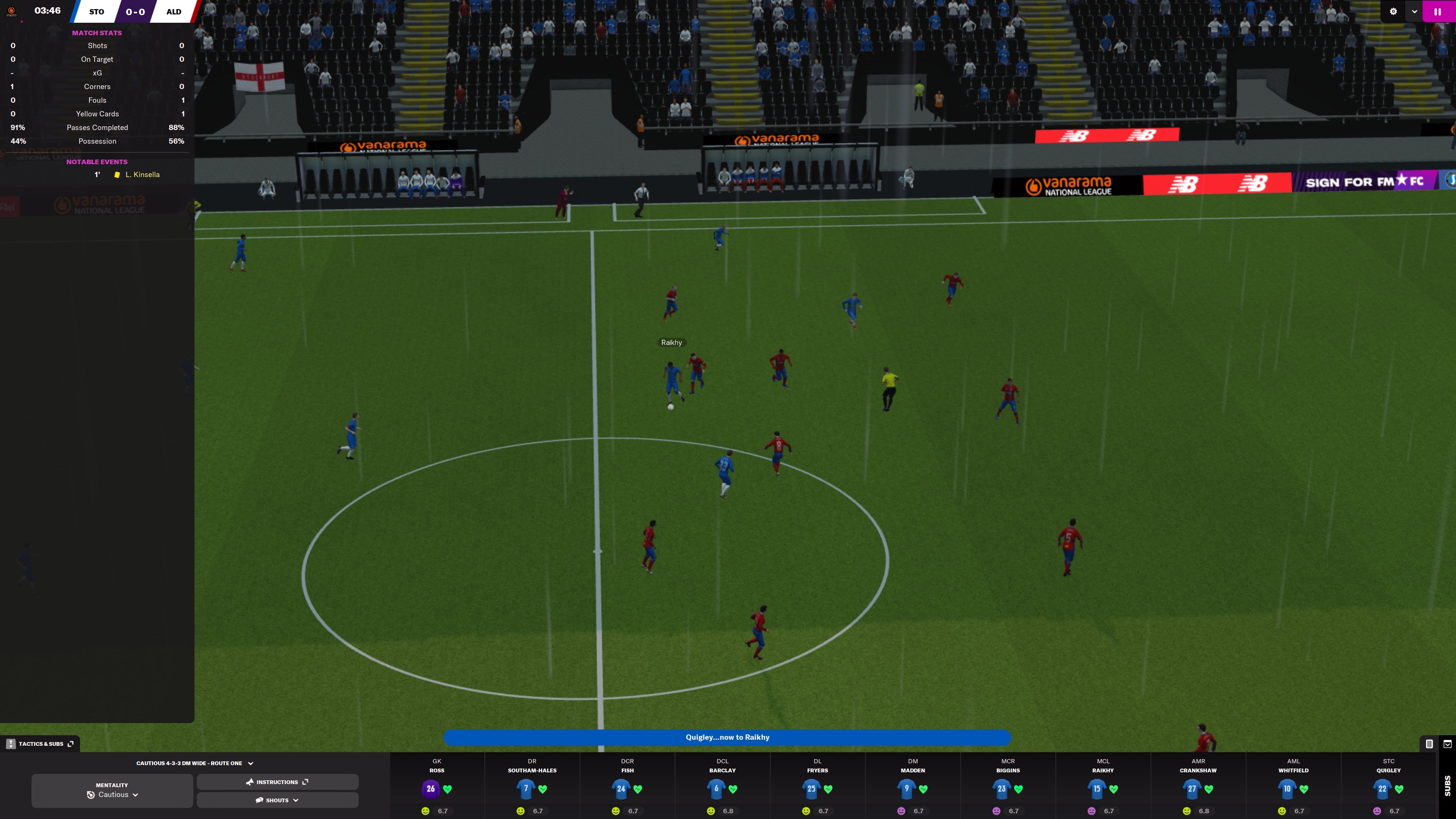
[ad_1]
Barry Hattrick has just signed a two-year contract with Stockport County FC. The 36-year-old former full-back, a Stockport native and lifelong fan of the Vanarama National League club, has a tactical style best described as ‘my dad after three pints’. Route-one, 4-4-2, and no ‘larking about’. He thinks a gegenpress is something you use to get the creases out of your trousers.
Hattrick is a quintessentially English anachronism, whose ignorance of the modern game represents my own unfamiliarity with modern Football Manager. It’s been quite some time since I last sported the greying temples and Fray-Bentos paunch of football’s favourite scapegoat, and returning to Football Manager is a bit like meeting up with an old girlfriend after they’ve had their consciousness uploaded into an all-knowing AI. I vaguely recognise the face behind all the ones and zeroes, but that person I once snuggled up with on winter evenings has ascended into something vast, intimidating, and utterly obsessed with data.
There’s a long-running joke about Football Manager being ‘The Spreadsheet Game’. Quite frankly, this undersells the yawning chasm of analytics that FM 2022 opens up before you. Chief among the new features is the “Data hub”, a fathomless pit of charts, diagrams, and infographics that collates every scrap of information into one giant number library. Alongside visualisations of your general performance compared to the league average, there are analyses of upcoming opponents, reports of players compiled by your scouts, and team comparison charts on a wide variety of subjects, such as crossing, tackling, and defending.
Initially, I viewed the Data Hub as I would a lathe, a tool I’m sure is very useful in the right hands, but one I daren’t touch myself for fear of being mulched by its mechanisms. But Football Manager is adept at spreading its data through the game in ways that make it more digestible, while the game’s broader systems frequently conjure challenges that slowly encourage you to take this info onboard. For example, as well as being contained in the Data Hub, opponent analyses are sent to your inbox each week before the relevant match. These are accompanied by highlighted strengths and weaknesses that you can build bespoke tactics around, capitalising on your opponent’s poor goalkeeping record, or compensating for their attacking-oriented approach.

But Football Manager never gives you anything for free. You must balance tactical changes against your own team’s preferred playstyle, which builds in effectiveness the more you use it. When I came across a team that was strong against 4-4-2, I opted to switch to a 4-3-3 formation. The result was a dead first half, with neither team making any ground. In the second half I switched back to 4-4-2, and the following 45 minutes were far more active, with both teams creating and conceding a lot of chances. In the end I came away with a 2-1 victory, Stockport’s effectiveness in the formation winning out against my opponent’s ability to exploit it.
It’s thrilling to see your tactical changes play out on the pitch, watching as play extends to the wings when you instruct your players to attack with greater width, or pushing up your defensive line to thwart a team that likes to shoot from distance. In one game, a team I should have been beating comfortably was creating a worrying number of chances. The half-time analytics showed they were attacking almost exclusively down the wings, so I instructed my defence to force their wide plays inside, smothering their forward impetus for most of the second half.

The games are simply fun to watch too. New match-engine features touted by Sports Interactive include more fluid and flexible animations, and a greater emphasis on player stamina. Having not played last year’s edition, it’s hard to comment too much on the former. Your team can certainly put together some slick-looking plays, although they still robotically stumble the ball forward from time to time. More broadly, the engine seems highly dynamic, able to produce weird footballing quirks such as one striker’s shot hitting the post and bouncing off a defender before your other striker rushes up to slip it past the keeper. By comparison, the effect of the new stamina focus is much clearer. More aggressive playstyles will tire out your team quickly, leading to them making fewer runs or attempts to re-take possession. Fatigue also affects your season at large, with you constantly balancing match-fitness with the risk of injuries in training.
Frankly I have all the negotiating skills of a tourist lost in the souks of Marrakech, but Deadline Day is a pleasing bit of flair in a game that’s otherwise flatly presented.
Beyond sharpening up events on the pitch, FM 2022 also adds more depth to backroom managerial duties. Foremost among these changes are weekly staff meetings, where you meet up with your non-jersey wearing staff to adjust training schedules, assess player and team morale, and discuss the viability of new hires. Meanwhile, the transfer market has been livened up with the introduction of Deadline Day. Wrapping the UI in fluorescent yellow banding like some terrible crime scene, Deadline Day opens up a bespoke menu for last-minute deals while time briefly switches its countdown to hours rather than days.
I like Deadline Day. It isn’t massively relevant to a club with a transfer budget of the average annual household income, and frankly I have all the negotiating skills of a tourist lost in the souks of Marrakech, but it’s a pleasing bit of flair in a game that’s otherwise flatly presented. While the data-handling side of FM is highly reflective of top-tier football, the sterile UI and lumpen character models are much more Sunday league. The manager creator has apparently been overhauled, but customisation options are still limited. You can’t dress your manager in a tight-fitting sweater like Pep Guardiola, for example, or stick them in Arsene Wenger’s obscenely padded sports coat. You get a suit and tie and enough stress to turn a bird of paradise grey, and you’ll like it.

Football Manager 2022 is simultaneously an easy and a hard game to recommend. These games are so comprehensive now that revolutionary new features are hard to come by, and it isn’t like Sports Interactive can add a new theme to football, like Activision can with Call of Duty. Regardless, FM 22 doesn’t represent radical change, and if you invested in FM 21, then you probably need to think hard about whether you want to spend £40 on an updated player database and a handful of (good) new features.
That said, it’s important to point out that irrespective of the iterative design and even the football itself, Sports Interactive’s games are genuinely some of the best management experiences around. Not only are they phenomenally rich and tangible in terms of your influence on events, they also avoid a recurring problem in management games, that of cascading failure. No matter how badly you screw up in a match, your stadium isn’t going to get wiped out by a fire or a rampaging T-Rex. There’s always next week to right the ship, and the game provides you with all the information you need to steer your career back on course. Yes, sometimes a result will come down to simple quality of players, but there’s usually something you can do to affect the scoreline, to turn certain defeat into a well-earned draw and gradually push your squad back into winning form.

If like me you’ve been away for a while, or have never played FM before because your brain calcifies whenever someone says the word “football”, then FM22 is definitely the version to try. As someone who came in relatively unversed in the series’ recent history, I was surprised by how quickly I found myself poring over my rival’s tackling statistics and trying to find a cheap yet quality replacement for my injured starting full-back. If the game can do that for old Barry Hattrick, then it can do the same for you.
[ad_2]





